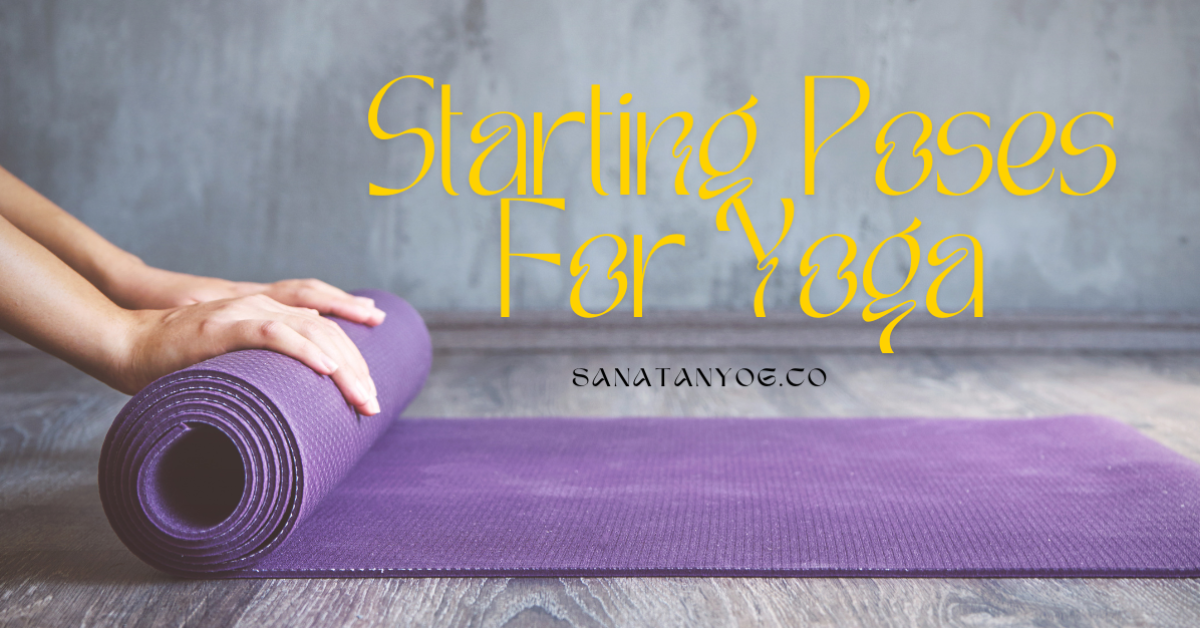Yoga is more than 5000 years old and has roots in India. Originally, it involved a system of physical exercises and postures, a special system of breathing, mediations, and five principles of conduct to optimize bodily functions and well-being. Yoga originated from the Sanskrit word “yuj” which means to join. Yoga aims to bring together the body, mind, and spirit. Therefore, it is necessary to get the starting poses for yoga right.
Since there are many styles of Yoga, each one focuses on some aspect or the other. For instance, Hatha yoga entails the use of physical postures (asanas), while Raja yoga mainly entails the use of meditation and mental control. Other well-known types are Vinyasa, Iyengar, Ashtanga and Bikram.
Yoga is indeed an exercise that has numerous advantages hence the following benefits; improved stretching ability, strength, balance, and cardiovascular fitness. This also assists in the diminishing of stress, anxiety, and depression stages since it entails relaxation and awareness. Also, the adverbial function of yoga is to lead customers to healthier eating, happy thinking, and caring for themselves.
Most Yoga exercises can be practiced by anyone, irrespective of age or body fitness, flexibility is the only constraint, but it can also be managed by getting the right starting poses for yoga. This makes it an efficient method of gaining all-round well-being of the body, mind, and spirit hence, promoting order in one’s life.
TOP 7 YOGA POSES FOR BEGINNERS
1. TADASANA
Tadasana or the Mountain Pose is the name given to one of the simplest and yet fundamental yoga poses which means, the ‘mountain posture’ in Sanskrit.
How to do it:
- Hold a position where you are standing with your feet apart the distance between the width of your hips.
- Roll flat, from the toes to the heels.
- Extend your back, and lift through the crown of your head.
- Take your shoulders and let them relax, roll them backward and down.
Benefits:
- Improves posture and balance
- Strengthens legs and core
- Increases flexibility
- Reduces stress and anxiety
- Boosts circulation
2. VRKASANA
Vrksasana or Tree Pose is one of the yoga asanas, a pose, that helps in extending the balance of an individual, and is one of the starting poses for yoga.
How to do it:
- Begin right foot stationary and with your legs shoulder width apart, erect your posture.
- Slide your butt back and place more of your weight on your left leg while lifting the right foot from the ground.
- Lay the sole of your right foot on your left inner thigh or calf muscle, but not on your knee.
- Stretch, with feet shoulder-width apart, arms by your side or above your head. Wait for a few deep breaths and then switch the side you are placing the phone on.
Benefits:
- Enhances balance and stability
- Builds leg muscles, specifically the ones in the lower region of the body including the abdominal region and the ankles.
- Improves posture and alignment
- Increases focus and concentration
- May assist in cases of sciatic issues (if practiced frequently)
3. TRIKONASANA
Trikonasana, or the Triangle pose, is one of the most essential and commonly performed forms of yoga with many rewarding qualities.
How to do it:
- The starting position involves keeping the legs wide enough for the width of one’s hips.
- Slide the right foot backward to a position parallel to the left foot, which is placed a little closer to the centerline.
- Bend your waist from the hips and place your right hand near your right shin or on the ground; raise your left arm to the ceiling.
- Look heavenward with your left thumb.
Benefits:
- Increases efficiency of the muscles in the legs, spine, and hips.
- Toning of the muscle of the back and the lower part of the body including the legs.
- Enhances balance and stability.
- Reduces stress and anxiety.
- Improves circulation and digestion.
4. VIRABHADRASAN
Virabhadrasana or Warrior pose is a strength-building asana that is special as one of the starting poses for yoga.
How to do it:
- One is required to begin with a standing lunge that involves placing the right leg forward and the left leg backward.
- Try to bend the knee that is in front of you and bring it to the point where it is touching the opposite heel.
- Stand with your arms up, with your fists clenched and resting either on top of your head or parallel with your forehead and touching.
- After several breaths, drop the leg switch to another one, and do the same.
Benefits:
- Strengthens more particularly the leg muscles, the abdominal and back muscles, and the arms.
- Improves balance and stability.
- Stretching loosens up the hip and shoulder muscles effective in flexibility.
- Boosts stamina and endurance.
- Improves concentration and state of mind.
5. ADHO MUKHO SVANOSANA
Adho Mukha Svanasana commonly referred to as Downward-Facing Dog is one of the starting poses for yoga. It is an inversion pose that also extends and directs the body and all four limbs.
How to do it:
- Begin on your fours on a firm surface and place the shoulders directly above your wrists and the hips above your knees.
- Bend your knees, pushing your hips back and up as far as is comfortable, fully extending your legs.
- Extend further through the back, engage your heel to the mat.
- Lean your head back as if you are looking in between your legs.
Benefits:
- Flexes hamstrings, calves, and shoulders.
- Successfully produces tension on the arm muscles, abdomen muscles, legs, etc.
- It should be noted that the practice contributes to the stimulation of blood circulation.
- Help in stimulating the body and the brain.
- Helps improve posture.
6. URDHVO MUKHO SVANOSANA
Urdhva Mukha Svanasana or Upward-Facing Dog Pose is a yoga pose that helps stretch your back, shoulder, arms, and leg muscles.
How to do it:
- Lay face down on your tummy, then place your hands on your sides, that is, your palms should rest on the parts of the body slightly above your shoulders.
- Push up, flatten your hands on the ground, and attempt to raise your chest and thighs from the ground.
- Tuck in your legs and point the heels back.
- Tilt your head back slightly and arch your back a little.
Benefits:
- Improves posture and flexibility
- Helps to tone and develop the abdominal muscles, legs, and all upper body muscles, especially the chest, shoulder, and arms.
- Stretches chest and abdomen
- Energizes the body
- May be useful in treating mild back pain
This pose is about moderate, somewhere in between, so pay attention to how you feel, and adjust accordingly.
7. PASCHIMOTTASANA
Seated forward bend or Paschimottasana is the yoga posture that helps in stretching the hamstrings, shoulders, and spine.
How to do it:
- Some of them stand straight with their legs straight also.
- Inhale, reach arms overhead.
- When you receive the go signal, breathe out and bend at the waist touching your toes.
- Exhaling, round your back and pulling the lower abdomen back and up, lengthen it slowly on each inhale.
Benefits:
- This was through enhanced elasticity of the fascia in the hamstrings, spine, and shoulders.
- Reduction of back pain and stiffness
- Reduced stress and anxiety
- Enhanced digestion and circulation
- A still mind and sound sleep
Conclusion
These seven Asanas form the core of your stable Yoga practice, especially for a beginner. They do not overwhelm you with complex exercises that contain the core movements, stretches, and breathing that can simply be incorporated into the exercises progressively as one develops. Yoga is not something that can be achieved one day but a process that a person undergoes to achieve better health. It is more important to listen to your body, appreciate the fun of moving, and get as much out of the practice of yoga as possible.


